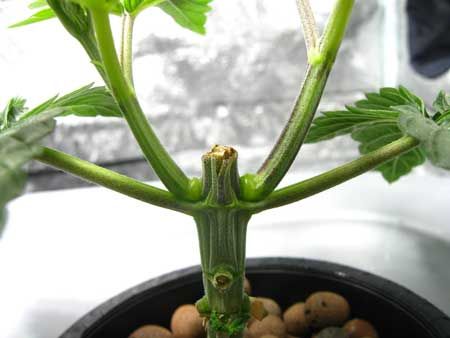Topping Cannabis
Topping cannabis is a great way to increase the number of bud sites exposed to full light. This can be applied to both outdoor and indoor growing styles. By increasing the number of bud sites and thereby increasing production, you can expect more flower at harvest. I recommend using a sharp pair of shears to top your plant. The Fiskars are a little expensive, but definitely the best in my opinion. I’ve had my pair for over 3 years now, so they last a long time too.
In this article, I’m going to talk about several topping practices used for cultivating cannabis.
The Basics – Pruning Techniques
Pruning redirects growth hormones and allows you to manipulate how your plant grows. Always use clean instruments when pruning and make cuts at a 45 degree angle to discourage moisture and debris from sitting in the wound. It takes a month or more for hormones to build up to pre-pruning levels. Never flower after pruning, wait at least 4-6 weeks to insure that your plant has time to heal and relocate its floral hormones.
Never remove healthy leaves from your plant, even if this allows more intense light to the buds. Removing leaves decreases chlorophyll production, stresses out your plant and stunts its growth. Remove only dead leaves and lower growth that is weak and shaded to increase airflow.
Topping
Topping cannabis may be the easiest way to increase your yield. It is as easy as cutting the very top of your plant off. This will most likely cause two new tops to form (causing your plant to look like a field goal post). Topping or cutting the meristem will shift greater growth concentration to lower branch tips.
FIM-ing
FIM-ing is very similar to topping where 90 percent of the bud is cut off, leaving 10 percent intact. According to some growers, this technique increases yield. Once the top has been FIM-ed, small clusters of dense buds form. However, we do not recommend FIM-ing your cannabis plants. In our experience, plants become huge and hedge like and buds are always smaller than desired.
Super Cropping
Super Cropping is a High-Stress Training technique. Plants will be bushier, provide more dense buds and have higher THC levels. In the wild, marijuana plants produce THC as a deterrent to protect themselves from plant eating animals. When a plant is damaged, their cannabinoid production is thrown into overdrive as a last ditch effort to protect themselves. Super Cropping should be used during the vegetative stage of plant growth. However, some growers insist super cropping should be done during flowering to increase THC levels.
Bending and Training
The goal of bending and training branches is to increase the number of buds exposed to direct sunlight. Bending is much easier on plants when compared to pruning. To bend a plant, first choose a young branch that is pliable and move it in the desired direction. Tie it in place with a string or use a Trellis net for support. Try and create an even canopy by bending plants horizontally. This will encourage buds to grow vertically and each bud will turn into an impressive flower because it received more light.
No Pruning
Not pruning has its advantages as well. Many gardeners do not prune at all when growing short clone crops around 3 feet tall. Clones are usually vegged for up to 2 weeks and then flowered indoors in 3 gallon pots. Since plants tend to be small, they can be grouped closely together and are easy to handle and move.
